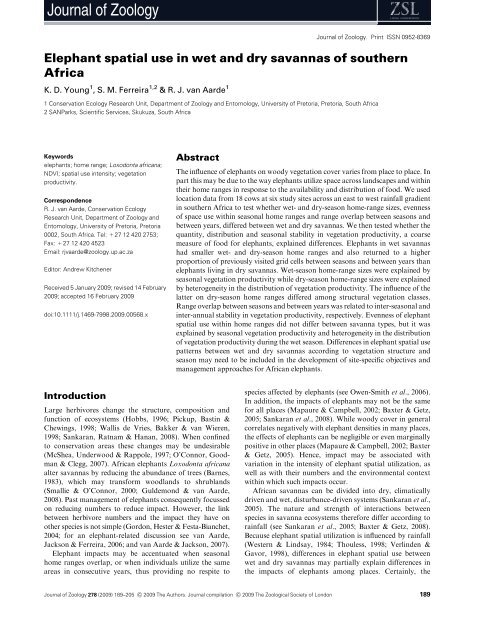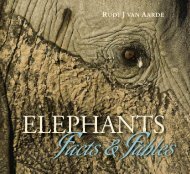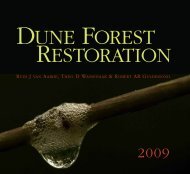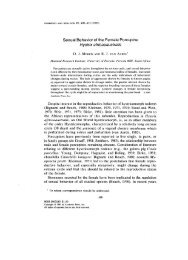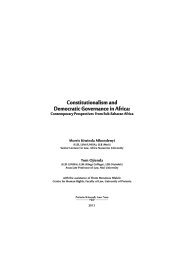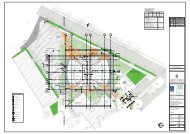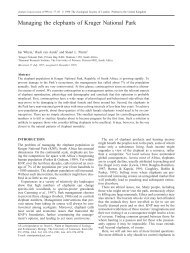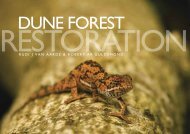Journal of Zoology - CERU - University of Pretoria
Journal of Zoology - CERU - University of Pretoria
Journal of Zoology - CERU - University of Pretoria
You also want an ePaper? Increase the reach of your titles
YUMPU automatically turns print PDFs into web optimized ePapers that Google loves.
<strong>Journal</strong> <strong>of</strong> <strong>Zoology</strong>Elephant spatial use in wet and dry savannas <strong>of</strong> southernAfricaK. D. Young 1 , S. M. Ferreira 1,2 & R. J. van Aarde 1<strong>Journal</strong> <strong>of</strong> <strong>Zoology</strong>. Print ISSN 0952-83691 Conservation Ecology Research Unit, Department <strong>of</strong> <strong>Zoology</strong> and Entomology, <strong>University</strong> <strong>of</strong> <strong>Pretoria</strong>, <strong>Pretoria</strong>, South Africa2 SANParks, Scientific Services, Skukuza, South AfricaKeywordselephants; home range; Loxodonta africana;NDVI; spatial use intensity; vegetationproductivity.CorrespondenceR. J. van Aarde, Conservation EcologyResearch Unit, Department <strong>of</strong> <strong>Zoology</strong> andEntomology, <strong>University</strong> <strong>of</strong> <strong>Pretoria</strong>, <strong>Pretoria</strong>0002, South Africa. Tel: +27 12 420 2753;Fax: +27 12 420 4523Email: rjvaarde@zoology.up.ac.zaEditor: Andrew KitchenerReceived 5 January 2009; revised 14 February2009; accepted 16 February 2009doi:10.1111/j.1469-7998.2009.00568.xAbstractThe influence <strong>of</strong> elephants on woody vegetation cover varies from place to place. Inpart this may be due to the way elephants utilize space across landscapes and withintheir home ranges in response to the availability and distribution <strong>of</strong> food. We usedlocation data from 18 cows at six study sites across an east to west rainfall gradientin southern Africa to test whether wet- and dry-season home-range sizes, evenness<strong>of</strong> space use within seasonal home ranges and range overlap between seasons andbetween years, differed between wet and dry savannas. We then tested whether thequantity, distribution and seasonal stability in vegetation productivity, a coarsemeasure <strong>of</strong> food for elephants, explained differences. Elephants in wet savannashad smaller wet- and dry-season home ranges and also returned to a higherproportion <strong>of</strong> previously visited grid cells between seasons and between years thanelephants living in dry savannas. Wet-season home-range sizes were explained byseasonal vegetation productivity while dry-season home-range sizes were explainedby heterogeneity in the distribution <strong>of</strong> vegetation productivity. The influence <strong>of</strong> thelatter on dry-season home ranges differed among structural vegetation classes.Range overlap between seasons and between years was related to inter-seasonal andinter-annual stability in vegetation productivity, respectively. Evenness <strong>of</strong> elephantspatial use within home ranges did not differ between savanna types, but it wasexplained by seasonal vegetation productivity and heterogeneity in the distribution<strong>of</strong> vegetation productivity during the wet season. Differences in elephant spatial usepatterns between wet and dry savannas according to vegetation structure andseason may need to be included in the development <strong>of</strong> site-specific objectives andmanagement approaches for African elephants.IntroductionLarge herbivores change the structure, composition andfunction <strong>of</strong> ecosystems (Hobbs, 1996; Pickup, Bastin &Chewings, 1998; Wallis de Vries, Bakker & van Wieren,1998; Sankaran, Ratnam & Hanan, 2008). When confinedto conservation areas these changes may be undesirable(McShea, Underwood & Rappole, 1997; O’Connor, Goodman& Clegg, 2007). African elephants Loxodonta africanaalter savannas by reducing the abundance <strong>of</strong> trees (Barnes,1983), which may transform woodlands to shrublands(Smallie & O’Connor, 2000; Guldemond & van Aarde,2008). Past management <strong>of</strong> elephants consequently focussedon reducing numbers to reduce impact. However, the linkbetween herbivore numbers and the impact they have onother species is not simple (Gordon, Hester & Festa-Bianchet,2004; for an elephant-related discussion see van Aarde,Jackson & Ferreira, 2006; and van Aarde & Jackson, 2007).Elephant impacts may be accentuated when seasonalhome ranges overlap, or when individuals utilize the sameareas in consecutive years, thus providing no respite tospecies affected by elephants (see Owen-Smith et al., 2006).In addition, the impacts <strong>of</strong> elephants may not be the samefor all places (Mapaure & Campbell, 2002; Baxter & Getz,2005; Sankaran et al., 2008). While woody cover in generalcorrelates negatively with elephant densities in many places,the effects <strong>of</strong> elephants can be negligible or even marginallypositive in other places (Mapaure & Campbell, 2002; Baxter& Getz, 2005). Hence, impact may be associated withvariation in the intensity <strong>of</strong> elephant spatial utilization, aswell as with their numbers and the environmental contextwithin which such impacts occur.African savannas can be divided into dry, climaticallydriven and wet, disturbance-driven systems (Sankaran et al.,2005). The nature and strength <strong>of</strong> interactions betweenspecies in savanna ecosystems therefore differ according torainfall (see Sankaran et al., 2005; Baxter & Getz, 2008).Because elephant spatial utilization is influenced by rainfall(Western & Lindsay, 1984; Thouless, 1998; Verlinden &Gavor, 1998), differences in elephant spatial use betweenwet and dry savannas may partially explain differences inthe impacts <strong>of</strong> elephants among places. Certainly, the<strong>Journal</strong> <strong>of</strong> <strong>Zoology</strong> 278 (2009) 189–205 c 2009 The Authors. <strong>Journal</strong> compilation c 2009 The Zoological Society <strong>of</strong> London 189
K. D. Young, S. M. Ferreira and R. J. van AardeElephant spatial use in wet and dry savannasFigure 1 Location <strong>of</strong> study sites across southernAfrica.Luangwa National Park (Zambia) in the east (Fig. 1).According to the rainfall-derived savanna types defined bySankaran et al. (2005), Etosha (centroid 19100 0 S, 16100 0 E),Khaudum (centroid 19100 0 S, 20140 0 E), and Ngamiland Section11 (NG11, centroid 18140 0 S, 22140 0 E) were dry, climaticallydriven savannas, while Kafue (centroid 15120 0 S,25140 0 E), Lower Zambezi (centroid 15130 0 S, 29130 0 E) andSouth Luangwa (centroid 13100 0 S, 31130 0 E) were wet disturbance-drivensavannas. The boundaries <strong>of</strong> study siteswere defined by the furthest extent <strong>of</strong> elephant locationsassociated with each conservation area over the studyperiod. Based on the Global Land Cover 2000 Project(Mayaux et al., 2003), the relative proportions <strong>of</strong> woodyand herbaceous cover differed among study sites. In addition,because Kafue, Lower Zambezi and South Luangwawere unfenced, and elephants ranged beyond conservationarea boundaries, these three study sites included areas wherecroplands were mixed with open vegetation. Boreholes inEtosha and Khaudum provided additional drinking waterfor wildlife. Kafue was situated beside a large artificial lake.In Kafue, rivers, lakes, pans and other wetlands alsoprovided surface water, as was the case in NG11, LowerZambezi and South Luangwa.DataWe used location datasets for 18 elephant cows from the sixstudy sites (three cows per study site). Each <strong>of</strong> these cowslived in a breeding herd and was fitted with a neck collarcontaining a satellite tracking unit (Africa Wildlife Tracking,<strong>Pretoria</strong>, South Africa). The dataset for each cowincluded daily locations during two consecutive wet andtwo consecutive dry seasons. Elephants at each site weretracked for 2-year periods between December 2002 andMarch 2006 (Table 2). Daily locations were advanced by 2hours every week, thereby reducing the likelihood <strong>of</strong> theselocations being dictated by diurnal activity rhythms.We extracted monthly rainfall data from weather stationsclose to, or within each study site. For Khaudum, where nosuch weather stations existed, we calculated monthly meanvalues from interpolated rainfall surfaces available fromhttp://www.worldclim.org/. We used monthly rainfall datato distinguish between wet and dry seasons. We defined corewet seasons as those sequential months that cumulativelyreceived 70% <strong>of</strong> the annual rainfall. Core dry seasons werethose sequential months that received o2% <strong>of</strong> the annualrainfall (Table 2).We used the NDVI as a measure <strong>of</strong> vegetation productivity.We downloaded NDVI data for each month fromDecember 2002 to March 2006 from http://free.vgt.vito.be/.Data were at a resolution <strong>of</strong> 1 km 2 , with NDVI valuescalculated from 10 day composites <strong>of</strong> remotely sensedimages from SPOT4 and SPOT5 satellites.Elephant spatial useWe calculated three measures <strong>of</strong> spatial use. Home-range sizeserved as a measure <strong>of</strong> spatial use at the landscape scale.Utilization uniformity measured how evenly elephant locationswere spaced within home ranges. Repeated visits to gridcells between seasons and between years served as a measure<strong>of</strong> inter-seasonal and inter-annual spatial use intensity.For each elephant we calculated 95% fixed kernel homerangesizes using the Animal Movement Extension (Hooge& Eichenlaub, 1997) for two core wet seasons and two coredry seasons, using ArcView GIS 3.3 (Environmental SystemsResearch Institute Inc., Redlands, CA, USA). For eachelephant we also calculated the seasonal differences inhome-range size as wet-season values minus the followingdry-season values.We used a clumping index (R) <strong>of</strong> elephant locationswithin home ranges as a measure <strong>of</strong> how evenly elephantsused space. For each elephant- and season-specific set <strong>of</strong>locations, we calculated the observed average nearest<strong>Journal</strong> <strong>of</strong> <strong>Zoology</strong> 278 (2009) 189–205 c 2009 The Authors. <strong>Journal</strong> compilation c 2009 The Zoological Society <strong>of</strong> London 191
Elephant spatial use in wet and dry savannasK. D. Young, S. M. Ferreira and R. J. van AardeTable 2 Mean annual precipitation and core seasons for study sitesMean AnnualCore season monthsStudy sitePrecipitation(standarddeviation) (mm)Collectionperiod(years) Wet season 1 Wet season 2 Dry season 1 Dry season 2Etosha 376 (112) 25 December 2002–March 2003December 2003–March 2004June 2003–September 2003June 2004–September 2004Khaudum 524 a 50 December 2004–March 2005December 2005–March 2006June 2005–September 2005June 2006–September 2006NG11 430 (190) 20 December 2004–March 2005December 2005–March 2006June 2005–September 2005June 2006–September 2006Kafue b 783 (234) 17 December 2003–March 2004December 2004–March 2005June 2003–September 2003June 2004–September 2004LowerZambezi667 (204) 10 December 2004–March 2005December 2005–March 2006June 2005–September 2005June 2006–September 2006SouthLuangwa802 (145) 21 December 2004–March 2005December 2005–March 2006June 2005–September 2005June 2006–September 2006Mean annual precipitation was calculated from monthly data from weather stations within or in close proximity to study areas. For Khaudum only,monthly data were obtained from interpolated rainfall surfaces downloaded from the worldclim website http://www.worldclim.org/. Numbers inbrackets are standard deviation <strong>of</strong> the mean. Core wet seasons were those consecutive months that cumulatively received 70% <strong>of</strong> the annualrainfall. Core dry seasons were those months that cumulatively received o2% <strong>of</strong> the annual rainfall.a No standard deviation available.b Note the order <strong>of</strong> core seasons for Kafue is asynchronous with those <strong>of</strong> other study sites.neighbour distance (d o ). We then randomly distributed asimilar number <strong>of</strong> locations and also estimated an averagenearest neighbour distance (d e ). From these we derived R asd o /d e . Values 41 reflected dispersed distributions (uniformutilization), those o1 were clumped (patchy utilization),while values <strong>of</strong> 1 represented a random distribution (seeMitchell, 2005). For each elephant we also calculatedseasonal differences in utilization uniformity as wet-seasonvalues minus the following dry-season values.Our measure <strong>of</strong> inter-seasonal and inter-annual repeatedvisits between core seasons was the fraction <strong>of</strong> the total areavisited in both core seasons (inter-seasonal: wet and dry; dryand wet; inter-annual: wet and wet; dry and dry). Tocalculate this we divided each elephant- and season-specifichome range into grid cells <strong>of</strong> 5 km 2 and calculated thefraction <strong>of</strong> the total number <strong>of</strong> grid cells visited in eitherseason that was visited during both seasons. We assumedthat 5 km 2 represented most <strong>of</strong> an elephant cow’s dailyoperating range, taking into account their daily waterrequirements (Stokke & du Toit, 2002; de Beer et al., 2006;Smit, Grant & Devereux, 2007).We compared season-specific home-range size and utilizationuniformity with two-tailed t-tests (Zar, 1984). Forinter-seasonal and inter-annual repeated visits we used thenon-parametric Kolmogorov–Smirnov test.Vegetation productivityWe divided each study site into 1 km 2 grid cells (the resolution<strong>of</strong> our NDVI data). For each grid cell we calculated thesum <strong>of</strong> the maximum NDVI values (one value per month)for the core seasons for which we studied elephants. Themean <strong>of</strong> the summed values <strong>of</strong> grid cells measured seasonalvegetation productivity (Pettorelli et al., 2005), and thestandard deviation <strong>of</strong> the summed values among grid cellsmeasured heterogeneity in the spatial distribution <strong>of</strong> vegetationproductivity (Murwira & Skidmore, 2005). For eachstudy site we also calculated seasonal differences from thewet to the dry season for each measure. We grouped thestudy sites according to wet and dry savanna types andcompared our vegetation productivity measures betweensavanna types using two-tailed t-tests.We also calculated season-specific vegetation productivitymeasures for grid cells within study sites groupedaccording to structural vegetation classes (Table 3), definedby Eiten (1968) and consistently assigned by Mayaux et al.(2003) across the whole <strong>of</strong> the African continent in theGlobal Land Cover 2000 Project.To measure the stability in the spatial distribution <strong>of</strong>vegetation productivity for each study site between seasons(wet to dry and dry to wet), and between years (wet to wetand dry to dry), we calculated a temporal autocorrelation <strong>of</strong>the sum <strong>of</strong> maximum NDVI grid-cell values between seasonsand between years (see Rossi et al., 1992 for explanation).To do this, we created a lagged-scatter plot (Chatfield,1975) for all grid cells <strong>of</strong> each study site for each seasonalcombination (wet to dry; dry to wet; wet to wet and dry todry). On the scatter plot, every grid cell represented a pointwith the sum <strong>of</strong> maximum NDVI values at time (t) on the x-axis, and the sum <strong>of</strong> maximum NDVI values at time (t+1)on the y-axis. Pearson’s correlation coefficient r for eachseasonal combination served as a measure <strong>of</strong> stability.We grouped our study sites according to savanna typesand compared the measures <strong>of</strong> intra-seasonal and interannualstability in the spatial distribution <strong>of</strong> vegetationproductivity with two-tailed t-tests.192<strong>Journal</strong> <strong>of</strong> <strong>Zoology</strong> 278 (2009) 189–205 c 2009 The Authors. <strong>Journal</strong> compilation c 2009 The Zoological Society <strong>of</strong> London
K. D. Young, S. M. Ferreira and R. J. van AardeElephant spatial use in wet and dry savannasTable 3 Proportion <strong>of</strong> the total number <strong>of</strong> grid cells (1 km 2 ) <strong>of</strong> each study site falling into structural vegetation classes as defined by Mayaux et al. (2003)Areas wherecroplandswere mixedwith openvegetationSwampbushlandand grasslandHerbaceouscoverbetween1 and 5%Herbaceouscover between5 and 15%without shrubcanopyShrub canopycover o20%.Herbaceouscover between15 and 40%Tree and shrubcanopy covero20%. Herbaceouscover 440%Shrub canopycover 415%.Canopy heighto5 m. No treelayerShrub canopycover 415%.Canopy heighto5 m. Sparsetree layer o15%Tree canopycover between15 and 40%.Canopy height45mTree canopycover440%.Canopyheight45mStudy siteEtosha 0.03 0.47 0.30 0.01Khaudum 0.35 0.55 0.11NG11 0.17 0.02 0.70 0.11 0.09Kafue 0.01 0.60 0.24 0.01 0.12Lower 0.03 0.16 0.37 0.07 0.06 0.01 0.31ZambeziSouthLuangwa0.50 0.02 0.48Elephant spatial use and vegetationproductivityWe regressed elephant home-range sizes (pooled for wet anddry savannas), our measure <strong>of</strong> utilization uniformity andour measure <strong>of</strong> inter-seasonal repeated visits against seasonspecificvegetation productivity measures per site and pervegetation structural class for each site.Selection within home rangesWe compared maximum NDVI for visited 5 km 2 grid cellswithin each 10 day period with the same number <strong>of</strong> randomlyselected 5 km 2 grid cells (pseudo-absences; Engler,Guisan, & Rechsteiner, 2004). We permutated this procedure10 000 times (see Gentle, 1943) and proposed a nullmodel that the mean value <strong>of</strong> visited grid cells was drawnfrom the same distribution as values from randomly selectedgrid cells within the same 10 day period. We rejected the nullmodel if Po0.05. For each elephant- and season-specific set<strong>of</strong> 10 day time periods, we calculated the proportion <strong>of</strong>periods where the mean maximum NDVI <strong>of</strong> visited gridcells was higher, and significantly (Po0.05) higher, thanthat for randomly selected grid cells.We further assessed whether elephant cows selected forareas <strong>of</strong> higher NDVI within structural vegetation classes(Mayaux et al., 2003). We removed the effect <strong>of</strong> time onNDVI values by calculating a residual maximum NDVI(rC j(t) ) value for each grid cell <strong>of</strong> each elephant’s seasonalhome range for each 10 day NDVI data period as followsrC jðtÞ ¼ C jðtÞX nj¼1C j =m ðtÞwhere C j(t) is the maximum NDVI value <strong>of</strong> cell j at time t,and m is the mean maximum NDVI value <strong>of</strong> all grid cells attime t. We then used a one-tailed t-test (Zar, 1984) tocompare mean residual maximum NDVI for visited gridcells with the same number <strong>of</strong> randomly selected grid cellswithin each structural vegetation class that was representedin each elephant- and season-specific home range for the firstwet and the first dry season <strong>of</strong> our study. We then calculatedthe proportion <strong>of</strong> residual mean maximum NDVI valuesthat were higher for visited than randomly selected grid cellsfor wet and dry savannas.ResultsElephant spatial useHome rangesHome-range sizes <strong>of</strong> elephant cows from dry savannas werethree- and four-fold those <strong>of</strong> elephants from wet savannasduring the wet and dry seasons, respectively (two-tailedt-test: wet season, t=3.35, d.f.=34, P=0.002; dry season,t=3.50, d.f.=34, P=0.001) (Fig. 2a). Although seasonaldifferences between wet- and dry-season home-range sizes<strong>Journal</strong> <strong>of</strong> <strong>Zoology</strong> 278 (2009) 189–205 c 2009 The Authors. <strong>Journal</strong> compilation c 2009 The Zoological Society <strong>of</strong> London 193
Elephant spatial use in wet and dry savannasK. D. Young, S. M. Ferreira and R. J. van Aarde(a)(b)(c)Home range sizeUtilization uniformityProportion <strong>of</strong> grid cellsvisited in both seasons25002000150010005001.00.50.00.40.30.20.1WetseasonDryseasonWetto dryDryto wetIntra-seasonalDryseasonWetseasonWetto wetSeasonaldifferenceSeasonaldifferenceDryto dryInter-annualRepeated visits between seasons and from year toyear within seasonsElephant cows living in wet savannas revisited a higherproportion <strong>of</strong> previously visited grid cells between seasons.Elephants from wet savannas revisited between two- andseven-fold the proportion <strong>of</strong> grid cells between seasons andin the same season from year to year than those living in drysavannas (Fig. 2c). Differences were significant from the wetseason to the following dry season (Kolmogorov–Smirnovtest, Po0.01), from the dry season to the following wetseason (Po0.01), and from one wet season to the next wetseason (Po0.01). From one dry season to the next dryseason, this difference was not significant (P40.05).Vegetation productivitySeasonal vegetation productivity (mean sum <strong>of</strong>maximum NDVI)Our results supported our expectation that vegetation productivitywas higher in wet than dry savannas (Fig. 3a).However, this difference was significant only for the wetseason (two-tailed t-test: t=2.52, d.f.=10, P=0.03), andnot for the dry season (t=1.77, d.f.=10, P=0.11)(Fig. 3a).We had expected that seasonal differences in vegetationproductivity would be larger for dry than wet savannas;however, the opposite was the case (t=2.05, d.f.=10,P=0.07) (Fig. 3a).Figure 2 Elephant spatial use in wet (shaded bars) and dry (clear bars)savannas. We show (a) home-range sizes calculated as the area <strong>of</strong>95% kernel density (km 2 ) and, (b) utilization uniformity as the clumpingindex (R) <strong>of</strong> elephant- and season-specific locations, for nineelephants from three wet savanna study sites (three per site), andnine elephants from three dry savanna study sites (three per site), fortwo wet seasons pooled and two dry seasons pooled. In (a) and(b) seasonal differences for home-range sizes and utilization uniformitieswere calculated as wet-season values minus the following dryseasonvalues. We also show (c) the inter-seasonal and inter-annualrepeated visits in wet and in dry savannas calculated as that fraction <strong>of</strong>grid cells visited in either season that were visited in both seasons. Allbars are mean 95% confidence interval.were larger in dry than wet savannas (Fig. 2a), this was notsignificant (t=1.60, d.f.=34, P=0.118).Utilization uniformity within home rangesContrary to our expectation, we found no evidence thatelephants from wet savannas utilized the space within theirhome ranges more evenly than their dry savanna counterpartsin the wet season, (two-tailed t-test: t=0.846,d.f.=34, P=0.403) or in the dry season (t=1.10,d.f.=34, P=0.277) (Fig. 2b). Furthermore, seasonal differencesin utilization uniformity within home ranges did notdiffer between wet and dry savannas, as expected (t=0.24,d.f.=34, P=0.815) (Fig. 2b).Heterogeneity in the spatial distribution <strong>of</strong>vegetation productivity (standard deviation sum <strong>of</strong>maximum NDVI)Our expectation that the spatial distribution <strong>of</strong> NDVIwould be more heterogeneous in dry savannas than wetsavannas did not hold in either the wet season (two-tailedt-test: t=0.26, d.f.=10, P=0.80), or the dry season(t=0.04, d.f.=10, P=0.97) (Fig. 3b). Our expectation thatseasonal differences in the spatial heterogeneity <strong>of</strong> vegetationproductivity would be less pronounced in wet than drysavannas was also not supported (t=0.25, d.f.=10,P=0.81) (Fig. 3b).Inter-seasonal and inter-annual stability in thedistribution <strong>of</strong> vegetation productivity (temporalautocorrelation in sum maximum NDVI)Contrary to our expectations, the spatial stability in thedistribution <strong>of</strong> vegetation productivity did not significantlydiffer between wet and dry savannas for any <strong>of</strong> our seasonalcombinations (Fig. 3c) as follows: from the wet season to thedry season: (two-tailed t-test: t=1.20, d.f.=4, P=0.30);from the dry season to the wet season (t=1.26, d.f.=4,P=0.28); from one wet season to the next (t=0.40, d.f.=4,P=0.71); from one dry season to the next (t=0.04, d.f.=4,194<strong>Journal</strong> <strong>of</strong> <strong>Zoology</strong> 278 (2009) 189–205 c 2009 The Authors. <strong>Journal</strong> compilation c 2009 The Zoological Society <strong>of</strong> London
K. D. Young, S. M. Ferreira and R. J. van AardeElephant spatial use in wet and dry savannasand stability in sum <strong>of</strong> maximum NDVI was found for thewet season to the following dry season, or for the wet seasonto the following wet season (Fig. 6).Selection within home rangesIn no study site were the mean maximum NDVI values <strong>of</strong>visited grid cells for any elephant consistently higher thanthat for randomly selected grid cells (Table 4). By contrast,within structural vegetation classes, grid cells visited byelephants in dry savannas had higher maximum NDVIvalues than randomly selected grid cells in the wet seasonfor 78% <strong>of</strong> 18 cases. Mean residual maximum NDVI values<strong>of</strong> visited grid cells were higher than randomly selected gridcells in 14 <strong>of</strong> 20 cases (70%) in the wet season for which eightcases were significantly different (Po0.05) (Table 5). Thiswas not the pattern for the dry season when only six <strong>of</strong> 16cases (38%) were higher for visited grid cells than randomlyselected grid cells, <strong>of</strong> which only two were significant.Elephants in wet savannas only visited grid cells with higherresidual maximum NDVI in comparison to that <strong>of</strong> randomlyselected grid cells in 42% <strong>of</strong> 24 cases during the wetseason, when only two <strong>of</strong> 10 were significant. During the dryseason, wet savanna elephants visited grid cells with higherresidual maximum NDVI values than randomly selectedgrid cells in 43% <strong>of</strong> 21 cases <strong>of</strong> which seven <strong>of</strong> 14 weresignificant.DiscussionIn our study, spatial use by elephants differed between wetand dry savannas. Wet savanna elephants ranged oversmaller seasonal home ranges than those living in drysavannas and returned to more than two-fold the proportion<strong>of</strong> previously visited grid cells between seasons andbetween years than their dry savanna counterparts.These repeated visits to the same places within seasons,between seasons and across years may accentuate the impact<strong>of</strong> elephants on vegetation (see Owen-Smith et al., 2006;O’Connor et al., 2007), particularly on woody vegetation(see Guldemond & van Aarde, 2008 and references therein).Furthermore, together with fire, elephant foraging on woodyseedlings and saplings can depress regeneration <strong>of</strong> woodlandareas (Dublin et al., 1990; see also Baxter & Getz,2005). Hence repeated returns to the same woodland areaswithin and between seasons could reduce regeneration overlonger time scales, particularly since family units discriminatebetween patches to select the highest density <strong>of</strong> palatablespecies (Stokke & du Toit, 2002). This will alsoinfluence species composition. Furthermore, elephants mayalso revisit places to take advantage <strong>of</strong> compensatorygrowth <strong>of</strong> previously impacted vegetation (Jachmann &Bell, 1985; Smallie & O’Connor, 2000), thus reinforcingtheir impacts at a particular site. The ‘legacy’ effect (Sankaranet al., 2008), where elephant impacts at a site aredependent on previous levels <strong>of</strong> elephant activity there,may be consistent with our interpretation. Thus, differencesin spatial use patterns between wet and dry savannas maypartially explain differences in elephant impacts on woodyvegetation at different places (see Guldemond & van Aarde,2008 and references therein).The spatial and temporal variability <strong>of</strong> rainfall inducesheterogeneity in primary productivity and thus the qualityand distribution <strong>of</strong> food in savannas (Scholes et al., 2003).Accordingly, we expected that wet savannas, which receivedhigher relative mean annual rainfall over longer wet-seasondurations than dry savannas, would have higher relativeseasonal vegetation productivity (mean sum <strong>of</strong> maximumNDVI), lower relative heterogeneity in the spatial distribution<strong>of</strong> vegetation productivity (standard deviation sum <strong>of</strong>maximum NDVI) and more stable distribution <strong>of</strong> vegetationproductivity between seasons, than dry savannas.Because home ranges reflect an animal’s nutritional requirements(see Schoener, 1981), and for elephants smaller rangessuggest higher quality home ranges (Wittemyer et al.,2007a), we further expected that differences in the quantity,distribution and stability <strong>of</strong> vegetation productivity as acoarse measure <strong>of</strong> food availability (Murwira & Skidmore,2005; Chamaille´-Jammes et al., 2007a; Wittemyer et al.,2007b), should explain differences between wet and drysavanna elephant spatial use patterns above.In support <strong>of</strong> our expectations, seasonal vegetation productivitywas higher in wet than in dry savannas during thewet season, and correspondingly wet-season elephant homerangesizes decreased with increasing seasonal vegetationproductivity. Furthermore, elephant spatial use within wetseasonhome ranges became more even with increasingseasonal vegetation productivity. In contrast, however,Figure 4 Home-range size (km 2 ) as a function <strong>of</strong> seasonal vegetation productivity and heterogeneity in the spatial distribution <strong>of</strong> vegetationproductivity calculated for (a) all grid cells within a study site; and (b–g) grid cells within a study site belonging to structural vegetation classes (landcover classes) as defined by Mayaux et al. (2003). For (a), plots comprise data from nine elephants from three wet (m) (three per study site), andnine elephants from three dry (&) (three per study site) for two wet seasons pooled and two dry seasons pooled. For (b–g) plots are as for (a), butcomprise data only from study sites with that structural vegetation class present (as shown in brackets). Lines were fitted only in cases where asignificant relationship (Po0.05) (solid line), or (Po0.10) (dashed line) existed. Structural vegetation classes shown are for: (b) Tree canopy coverbetween 15 and 40% with a canopy height 45 m (Khaudum, NG11, Kafue, Lower Zambezi, South Luangwa). (c) Shrub canopy cover 415% witha canopy height o5 m and a sparse tree layer o15% (NG11, Kafue, Lower Zambezi, South Luangwa). (d) Shrub canopy cover 415% with acanopy height o5 m and no tree layer (Khaudum, NG11, Kafue, Lower Zambezi, South Luangwa). (e) Tree and shrub canopy cover o20% andherbaceous cover 440% (Etosha, Khaudum, NG11, Lower Zambezi, South Luangwa). (f) Shrub canopy cover o20% and herbaceous coverbetween 15 and 40% (Etosha, Khaudum, NG11, Lower Zambezi). (g) Areas where croplands were mixed with open vegetation (Kafue, LowerZambezi, South Luangwa).<strong>Journal</strong> <strong>of</strong> <strong>Zoology</strong> 278 (2009) 189–205 c 2009 The Authors. <strong>Journal</strong> compilation c 2009 The Zoological Society <strong>of</strong> London 197
K. D. Young, S. M. Ferreira and R. J. van AardeElephant spatial use in wet and dry savannasProportion <strong>of</strong> grid-cellsvisited in both seasons(a)0.20.1Inter-seasonalWet season to dry season0.25 0.50 0.75 1.00Stability <strong>of</strong> sum <strong>of</strong>maximum NDVIProportion <strong>of</strong> grid-cellsvisited in both seasons(c)0.60.40.2Inter-annualWet season to wet season0.25 0.50 0.75 1.00Stability <strong>of</strong> sum <strong>of</strong>maximum NDVIDry season to wet seasonDry season to dry seasonProportion <strong>of</strong> grid-cellsvisited in both seasons(b)0.20.1–0.25 0.25 0.50 0.75 1.00–0.1Stability <strong>of</strong> sum <strong>of</strong>maximum NDVIProportion <strong>of</strong> grid-cellsvisited in both seasons(d)0.40.20.25 0.50 0.75 1.00Stability <strong>of</strong> sum <strong>of</strong>maximum NDVIFigure 6 Relationships between the proportion <strong>of</strong> repeated visits to grid cells between seasons for nine elephants from three wet savanna studysites (m) (three per site), and nine elephants from three dry savanna study sites (&) (three per site), and the stability in the spatial distribution <strong>of</strong>sum <strong>of</strong> maximum NDVI (see ‘Materials and methods’) from the (a) wet to dry season; (b) dry to wet season; (c) wet to wet season; (d) dry to dryseason. Lines were fitted only in cases where a significant relationship (Po0.10) existed.distribution <strong>of</strong> permanent surface water sources and thereforemay range further and wider than during the dryseason, when they typically remain in close proximity tosurface water to provide for young and neonate needs(Stokke & du Toit, 2002; Redfern et al., 2005; Chamaille´-Jammes, Valeix & Fritz, 2007b; Smit et al., 2007; Wittemyeret al., 2007a). Hence the availability <strong>of</strong> surface water defineskey-resource areas by shaping the seasonal restriction <strong>of</strong> theforaging range (Chamaille´-Jammes et al., 2007b, 2008). Ourresult that home-range size was influenced by vegetationproductivity only during the wet season is consistent withfood resources being an important determinant <strong>of</strong> elephantspatial use when elephant breeding herds are less restrictedby the availability <strong>of</strong> surface water. In contrast, during thedry season, the lack <strong>of</strong> influence <strong>of</strong> seasonal vegetationproductivity is consistent with surface water being theprimary determinant <strong>of</strong> foraging range. The apparent lack<strong>of</strong> selection by both wet and dry savanna elephants withinstructural vegetation classes within dry-season home rangesis also consistent with the suggestion that water is a keydeterminant for elephant spatial use during this season.However, the decrease in dry-season home-range sizes withincreasing heterogeneity in the distribution <strong>of</strong> vegetationproductivity suggests that when surface water is limited,elephant foraging may be more efficient in heterogeneouslandscapes (Grainger, van Aarde & Whyte, 2005; MurwiraFigure 5 Utilization uniformity (average nearest neighbour statistic) as a function <strong>of</strong> seasonal vegetation productivity and heterogeneity in thespatial distribution <strong>of</strong> vegetation productivity calculated for (a) all grid cells within a study site; and (b–g) grid cells within a study site <strong>of</strong> differentstructural vegetation classes (land cover classes) as defined by Mayaux et al. (2003) see below for descriptions. For (a), plots comprise data fromnine elephants from three wet (m) (three per study site), and nine elephants from three dry (&) (three per study site) for two wet seasons pooledand two dry seasons pooled. For (b–g) plots are as for (a), but comprise data only from study sites with that structural vegetation class present (asshown in brackets). Lines were fitted only in cases where a significant relationship (Po0.05) (solid line), or (Po0.10) (dashed line) existed.Structural vegetation classes shown are for: (b) Tree canopy cover between 15 and 40% with a canopy height 45 m (Khaudum, NG11, Kafue,Lower Zambezi, South Luangwa). (c) Shrub canopy cover 415% with a canopy height o5 m and a sparse tree layer o15% (NG11, Kafue, LowerZambezi, South Luangwa). (d) Shrub canopy cover 415% with a canopy height o5 m and no tree layer (Khaudum, NG11, Kafue, Lower Zambezi,South Luangwa). (e) Tree and shrub canopy cover o20% and herbaceous cover 440% (Etosha, Khaudum, NG11, Lower Zambezi, SouthLuangwa). (f) Shrub canopy cover o20% and herbaceous cover between 15 and 40% (Etosha, Khaudum, NG11, Lower Zambezi). (g) Areaswhere croplands were mixed with open vegetation (Kafue, Lower Zambezi, South Luangwa).<strong>Journal</strong> <strong>of</strong> <strong>Zoology</strong> 278 (2009) 189–205 c 2009 The Authors. <strong>Journal</strong> compilation c 2009 The Zoological Society <strong>of</strong> London 199
Elephant spatial use in wet and dry savannasK. D. Young, S. M. Ferreira and R. J. van AardeTable 4 Proportion <strong>of</strong> 10 day time periods where mean maximum NDVI values <strong>of</strong> visited grid cells were higher than for randomly selected gridcellsProportion <strong>of</strong> times mean maximum NDVI is higher for visited than randomly selected grid cellsAll seasonsElephant combined Wet 1 Dry 1 Wet 2 Dry 2Etosha 3 0.90 0.88 0.50 0.90 0.50 0.92 0.67 0.90 0.40Etosha 5 0.85 0.67 0.33 1.00 0.67 0.92 0.33 0.90 0.30Etosha 6 0.59 0.78 0.33 0.45 0.09 0.58 0.00 0.56 0.42Khaudum 4 0.59 1.00 0.33 0.38 0.13 0.27 0.18 0.73 0.09Khaudum 5 0.46 0.57 0.00 0.63 0.00 0.33 0.00 0.40 0.30Khaudum 6 0.58 0.67 0.56 0.50 0.00 0.67 0.36 0.45 0.00Botswana 6 0.51 0.62 0.14 0.38 0.00 0.58 0.08 0.22 0.11Botswana 8 0.54 0.80 0.40 0.38 0.13 0.36 0.00 0.50 0.25Botswana 10 0.47 0.50 0.00 0.38 0.13 0.58 0.17 0.38 0.25Kafue 1 0.54 0.45 0.09 0.29 0.00 0.70 0.00 0.71 0.00Kafue 3 0.74 0.67 0.17 0.86 0.00 0.86 0.29 0.60 0.00Kafue 8 0.63 0.67 0.25 0.43 0.00 1.00 0.17 0.43 0.14Zambezi 1 0.49 0.44 0.00 0.42 0.14 0.43 0.08 0.71 0.00Zambezi 3 0.74 0.50 0.00 0.86 0.00 0.81 0.27 1.00 0.29Zambezi 6 0.51 0.44 0.11 0.43 0.14 0.58 0.33 0.57 0.29Luangwa 1 0.60 0.60 0.20 0.44 0.11 0.67 0.17 0.67 0.22Luangwa 3 0.53 0.44 0.11 0.55 0.00 0.42 0.00 0.62 0.13Luangwa 5 0.62 0.67 0.33 0.56 0.11 0.44 0.00 0.61 0.19Each core season was divided into 12 time periods <strong>of</strong> 10 days. For each elephant and season we report the proportion <strong>of</strong> periods that themaximum NDVI values for visited grid cells was higher than that for an equal number <strong>of</strong> randomly selected grid cells within that elephant- andseason-specific home range. In italics, we also report the proportion <strong>of</strong> times that the difference was significant according to a one-tailed t-test(Po0.05).NDVI, normalized difference vegetation index.& Skidmore, 2005; de Beer & van Aarde, 2008), particularlybecause the spatial configuration <strong>of</strong> food and water iscritical during this season (Harris et al., 2008).Bearing in mind that seasonal vegetation productivitydiffered between wet and dry savannas but heterogeneity inthe distribution <strong>of</strong> vegetation productivity did not, weconclude that differences in vegetation productivity betweenwet and dry savannas explained differences in wet-seasonelephant home ranges, but that differences between dryseasonhome-range sizes in wet and dry savannas may beinfluenced by factors other than differences in vegetationproductivity alone.Vegetation structure differed between wet and dry savannas.Wet savannas mainly comprised tree- and shrubdominatedstructural vegetation classes, while dry savannasmainly comprised structural vegetation classes where shruband herbaceous cover predominated. Vegetation structurehas a large influence on NDVI values (see Mayaux et al.,2003; Geerken, Zaichik, & Evans, 2005), and therefore onvegetation productivity. Our analysis <strong>of</strong> suggests elephantspatial use as a function <strong>of</strong> vegetation productivity withinstructural vegetation classess, that vegetation structure explainsthe differing influence <strong>of</strong> vegetation productivity onelephant spatial use between seasons. Because grasses haverelatively high NDVI values during the wet season (vanBommel et al., 2006), the lack <strong>of</strong> influence <strong>of</strong> vegetationproductivity within any one structural vegetation class onwet-season home-range sizes appears consistent with elephantsprimarily selecting grasses during this season(O’Connor et al., 2007), regardless <strong>of</strong> structural vegetationclass. Hence, consistent with our conclusion above, thedifference in seasonal vegetation productivity between wetand dry savannas regardless <strong>of</strong> vegetation structure accountedfor differences in home-range size during the wetseason.In contrast, during the dry season, the influence <strong>of</strong>heterogeneity in the distribution <strong>of</strong> vegetation productivityon dry-season home-range sizes was important in tree- andshrub-dominated structural vegetation classes which wererepresented only in the wet savanna study sites. Becausegrasses senesce during the dry season elephants switch tobrowse to meet nutritional requirements (O’Connor et al.,2007). The higher heterogeneity in the distribution <strong>of</strong>vegetation productivity in these structural vegetation classesmay therefore reflect higher availability <strong>of</strong> the requiredcombination <strong>of</strong> browse and water (Harris et al., 2008). Ifso, differences in vegetation structure between wet and drysavannas rather than vegetation productivity alone mayexplain the differences in elephant spatial use between wetand dry savanna types during the dry season.Differences in vegetation structure between wet and drysavanna types may also explain why seasonal stability invegetation productivity, which did not differ between wet anddry savannas, nevertheless influenced elephant repeated visits.Repeated visits from one dry season to the next increasedwith the increasing stability <strong>of</strong> vegetation productivity,200<strong>Journal</strong> <strong>of</strong> <strong>Zoology</strong> 278 (2009) 189–205 c 2009 The Authors. <strong>Journal</strong> compilation c 2009 The Zoological Society <strong>of</strong> London
K. D. Young, S. M. Ferreira and R. J. van AardeElephant spatial use in wet and dry savannasTable 5 NDVI values for visited and randomly selected grid cells within land cover classesStudy siteand elephantcodeProportion<strong>of</strong> casesTree canopycover 440%.Canopy height45mTree canopycover between15% and 40%.Canopy height45mShrub canopycover 415%.Canopy heighto5 m. Sparsetree layer o15%Shrub canopycover 415%.Canopy heighto5 m. No treelayerTree and shrubcanopy covero20 %.Herbaceouscover 440%Shrub canopycover o20%.Herbaceouscover between15% and 40%Herbaceouscover between5% and 15%without shrubcanopySwampbushland andgrasslandAreas wherecroplands weremixed with openvegetationR V R V R V R V R V R V R V R V R VWet seasonEtosha3 0.002 0.064 a5 0.019 0.025 0.003 0.025 a6 0.084 0.070 0.043 0.010 aKhaudum4 Dry savannas0.055 0.041 0.026 0.027 a 0.020 0.0045 0.780.005 0.009 0.002 0.0126 0.033 0.057 a 0.027 0.009 0.054 0.009 aNG116 0.020 0.040 a 0.008 0.0058 0.004 0.047 a 0.001 0.01610 0.014 0.037Kafue1 0.012 0.014 0.007 0.014 0.010 0.0133 0.061 0.060 0.010 0.016 0.024 0.0348 0.046 0.011 a 0.019 0.038 0.030 0.024 0.035 0.025Lower Zambezi1 Wet savannas0.052 0.041 0.098 0.136 0.022 0.0873 0.420.023 0.015 0.020 0.036 a 0.015 0.0106 0.028 0.028 0.012 0.032South Luangwa1 0.055 0.063 0.014 0.0093 0.026 0.026 0.005 0.0205 0.058 0.029 0.008 0.019Dry seasonEtosha3 0.006 0.018 a5 0.009 0.025 a 0.005 0.0146 0.002 0.001 0.013 0.020Khaudum4 Dry savannas0.009 0.004 0.001 0.0085 0.380.004 0.002 0.010 0.0016 0.001 0.000<strong>Journal</strong> <strong>of</strong> <strong>Zoology</strong> 278 (2009) 189–205 c 2009 The Authors. <strong>Journal</strong> compilation c 2009 The Zoological Society <strong>of</strong> London 201
Elephant spatial use in wet and dry savannasK. D. Young, S. M. Ferreira and R. J. van AardeTable 5. Continued.Study siteand elephantcodeProportion<strong>of</strong> casesTree canopycover 440%.Canopy height45mTree canopycover between15% and 40%.Canopy height45mShrub canopycover 415%.Canopy heighto5 m. Sparsetree layer o15%Shrub canopycover 415%.Canopy heighto5 m. No treelayerTree and shrubcanopy covero20 %.Herbaceouscover 440%Shrub canopycover o20%.Herbaceouscover between15% and 40%Herbaceouscover between5% and 15%without shrubcanopySwampbushland andgrasslandAreas wherecroplands weremixed with openvegetationR V R V R V R V R V R V R V R V R VNG116 0.020 0.027 0.178 0.1428 0.058 0.042 0.041 0.02510 0.040 0.034 0.050 0.043Kafue1 0.010 0.007 0.004 0.002 0.014 0.0133 0.013 0.002 a 0.007 0.0058 0.005 0.023 a 0.010 0.012Lower Zambezi1 Wet savannas 0.055 0.040 0.022 0.006 a3 0.430.019 0.026 0.005 0.017 a 0.053 0.024 a 0.002 0.0126 0.023 0.026 0.006 0.018South Luangwa1 0.012 0.014 0.002 0.0013 0.027 0.018 0.006 0.0125 0.001 0.010 0.008 0.004Values are the mean residual maximum NDVI <strong>of</strong> visited (V) and an equal number <strong>of</strong> randomly selected grid cells (R) within structural vegetation classes defined by Mayaux et al. (2003), for eachelephant. Values in bold show where NDVI <strong>of</strong> visited grid cells are higher than that <strong>of</strong> randomly selected grid cells.a Indicates where differences are significant using a one-tailed t-test (Po0.05). Grey shading indicates an absence <strong>of</strong> that structural vegetation class in all elephant locations for that study site. Wealso show the proportion <strong>of</strong> cases for dry and for wet savanna study sites where the mean residual NDVI <strong>of</strong> visited grid cells within land cover classes was higher than that for randomly selectedgrid cells.NDVI, normalized difference vegetation index.202<strong>Journal</strong> <strong>of</strong> <strong>Zoology</strong> 278 (2009) 189–205 c 2009 The Authors. <strong>Journal</strong> compilation c 2009 The Zoological Society <strong>of</strong> London
K. D. Young, S. M. Ferreira and R. J. van AardeElephant spatial use in wet and dry savannaswhile repeated visits from the dry to the wet seasondecreased within increasing stability <strong>of</strong> vegetation productivity.Because herbaceous cover that predominated in thedry savanna sites is typically more temporally variable thanwoody vegetation (see Geerken et al., 2005; van Bommelet al., 2006), elephants living in wet savannas may simplyhave more opportunity to return to known stable sources <strong>of</strong>food and water than elephants living in dry savannas. Indirect contrast, the decrease in proportion <strong>of</strong> repeated visitsfrom the dry to the wet season with increasing stability mayreflect changes in elephant seasonal preferences and theirassociated movements from dry-season woody food sourcesto areas <strong>of</strong> wet-season grasses (O’Connor et al., 2007). Inthis case, dry savanna elephants may simply be presentedwith more choice than wet savanna elephants when water isnot limited during the wet season. The low variabilityobserved in the spatial stability <strong>of</strong> vegetation productivityfrom the dry to the wet season within wet savanna studysites in comparison to that in dry savanna study sitessupports our interpretation. Furthermore, elephants inEtosha and Khaudum (dry savannas) were located on gridcells with higher residual vegetation productivity than randomlyselected grid cells where herbaceous cover exceeded15% in nine <strong>of</strong> 11 cases during the wet season. In contrast,wet savanna elephants appeared to show little selection forplaces <strong>of</strong> higher relative NDVI in any one <strong>of</strong> the structuralvegetation classes during the wet season.We note that our study did not allow us to consider rangeoverlap between elephants as a measure <strong>of</strong> spatial useintensity. Such occurrences may amplify impacts where theyoccur. Furthermore, we were unable to consider the influence<strong>of</strong> elephant densities on the relationship betweenelephant spatial use and vegetation productivity. Such considerationmay further explain elephant spatial use in relationto water and food resources (e.g. Chamaille´-Jammeset al., 2008). Finally, we stress that we only considered thespatial use patterns <strong>of</strong> elephant cows as an indication <strong>of</strong> themovements <strong>of</strong> family units in this study. Intensity <strong>of</strong> spaceuse through time <strong>of</strong> elephant bulls is likely to be dissimilar tothat <strong>of</strong> family units and should also be considered.Nevertheless, our study showed that the intensity <strong>of</strong> rangeutilization in space and through time differed between wetand dry savanna types. In the wet season, these differencescould be assigned to differences in vegetation productivitybetween wet and dry savannas. In the dry season, theinfluence <strong>of</strong> vegetation productivity on elephant spatial usediffered according to vegetation structure. Differences in theinfluence <strong>of</strong> vegetation productivity within different vegetationstructural classes is also suggested as explanation fordifferences in repeated visits between wet and dry savannas.All <strong>of</strong> these findings may explain the different impacts thatelephants have on woody vegetation among sites (see Guldemond& van Aarde, 2008). Elephants contribute to thepersistence <strong>of</strong> woodland and grassland mosaics in savannasystems (Sankaran et al., 2008). Because differences invegetation structure between wet and dry savanna sitesseemed to alter the seasonal influence <strong>of</strong> vegetation productivityon elephant spatial use during the dry season andbetween seasons, the intensity <strong>of</strong> impacts on woody vegetationnoted for dry savannas may not be readily extrapolatedto wet savannas (see Guldemond & van Aarde, 2008).Differences in elephant spatial use patterns between wetand dry savannas therefore need to be accounted for in thedevelopment <strong>of</strong> site-specific objectives and managementapproaches for African elephants.AcknowledgementsThis study was funded through research grants from theInternational Fund for Animal Welfare, the Peace ParksFoundation, the US Fish and Wildlife Services, the ConservationFoundation Zambia and the <strong>University</strong> <strong>of</strong> <strong>Pretoria</strong>.The Ministry <strong>of</strong> the Environment & Tourism <strong>of</strong> Namibia,the Department <strong>of</strong> Wildlife and National Parks, Botswanaand the Zambian Wildlife Authority sanctioned and supportedour research.Referencesvan Aarde, R.J. & Jackson, T.P. (2007). Megaparks formetapopulations: addressing the causes <strong>of</strong> locally highelephant numbers in southern Africa. Biol. Conserv. 134,289–297.van Aarde, R.J., Jackson, T.P. & Ferreira, S.M. (2006).Conservation science and elephant management insouthern Africa. S. Afr. J. Sci. 102, 385–388.Barnes, R.F.W. (1983). The elephant problem in RuahaNational Park, Tanzania. Biol. Conserv. 26, 127–148.Baxter, P.W.J. & Getz, W.M. (2005). A model framedevaluation <strong>of</strong> elephant effects on tree and fire dynamics inAfrican savannas. Ecol. Appl. 15, 1331–1341.Baxter, P.W.J. & Getz, W.M. (2008). Development andparameterization <strong>of</strong> a rain- and fire-driven model forexploring elephant effects in African savannas. Environ.Model. Assess. 13, 221–242.de Beer, Y. & van Aarde, R.J. (2008). Does landscapeheterogeneity and water distribution explain aspects <strong>of</strong>elephant home range in southern Africa’s arid savannas?J. Arid Environ. 72, 2017–2025.de Beer, Y., Kilian, W., Versfeld, W. & van Aarde, R.J.(2006). Elephants and low rainfall alter woody vegetationin Etosha National Park, Namibia. J. Arid Environ. 64,412–421.Dublin, H.T., Sinclair, A.R.E. & McGlade, J. (1990). Elephantsand fire as causes <strong>of</strong> multiple stable states in theSerengeti-Mara woodlands. J. Anim. Ecol. 59, 1147–64.van Bommel, F.P.J., Heitkonig, I.M.A., Epema, G.F.,Ringrose, S., Bonyongo, C. & Veenendaal, E.M. (2006).Remotely sensed habitat indicators for predicting distribution<strong>of</strong> impala (Aepyceros melampus) in the OkavangoDelta, Botswana. J. Trop. Ecol. 22, 101–110.Chamaille´-Jammes, S., Fritz, H., Valeix, M., Murindagomo,F. & Clobert, J. (2008). Resource variability, aggregationand direct density dependence in an open context: the local<strong>Journal</strong> <strong>of</strong> <strong>Zoology</strong> 278 (2009) 189–205 c 2009 The Authors. <strong>Journal</strong> compilation c 2009 The Zoological Society <strong>of</strong> London 203
Elephant spatial use in wet and dry savannasK. D. Young, S. M. Ferreira and R. J. van Aarderegulation <strong>of</strong> an African elephant population. J. Anim.Ecol. 77, 135–144.Chamaille´-Jammes, S., Valeix, M. & Fritz, H. (2007a).Managing heterogeneity in elephant distribution: interactionsbetween elephant population density and surfacewateravailability. J. Appl. Ecol. 44, 625–633.Chamaille´-Jammes, S., Valeix, M. & Fritz, H. (2007b).Elephant management: why can’t we throw the babiesout with the artificial bathwater? Divers. Distrib. 13,663–665.Chatfield, C. (1975). The analysis <strong>of</strong> time series: theory andpractice. London: Chapman and Hall.Eiten, G. (1968). Vegetation forms. A classification <strong>of</strong> stands<strong>of</strong> vegetation based on structure, growth form <strong>of</strong> thecomponents, and vegetative periodicity. Bol. Inst. Bot.(San Paulo) 4, pp. 67.Engler, R., Guisan, A. & Rechsteiner, L. (2004). An improvedapproach for predicting the distribution <strong>of</strong> rare and endangeredspecies from occurrence and pseudo-absencedata. J. Appl. Ecol. 41, 263–274.Geerken, R., Zaichik, B. & Evans, J.P. (2005). Classifyingrangeland vegetation type and coverage from NDVI timeseries using Fourier Filtered Cycle Similarity. Int. J. Rem.Sens. 26, 5535–5554.Gentle, J.E. (1943). Random number generation and MonteCarlo methods. New York, USA: Springer-Verlag.Gordon, I.J., Hester, A.J. & Festa-Bianchet, M. (2004). Themanagement <strong>of</strong> wild large herbivores to meet economic,conservation and environmental objectives. J. Appl. Ecol.41, 1021–1031.Grainger, M., van Aarde, R.J. & Whyte, I. (2005). Landscapeheterogeneity and the use <strong>of</strong> space by elephants in theKruger National Park, South Africa. Afr. J. Ecol. 43,369–375.Guldemond, R.A.R. & van Aarde, R.J. (2008). A metaanalysis<strong>of</strong> the impact <strong>of</strong> African elephants on savannavegetation. J. Wildl. Mgmt. 72, 892–899.Harris, G.M., Russell, G.J., van Aarde, R.J. & Pimm, S.L.(2008). Habitat use <strong>of</strong> savanna elephants in southernAfrica. Oryx 42, 66–75.Hobbs, N.T. (1996). Modification <strong>of</strong> ecosystems by ungulates.J. Wildl. Mgmt. 60, 695–713.Hooge, P.N. & Eichenlaub, B. (1997). Animal movementextension to ArcView, ver. 1.1. Anchorage, AK, USA:Alaska Science Center – Biological Science Office, USGeological Survey.Jachmann, H. & Bell, R.H.V. (1985). Utilization by elephants<strong>of</strong> the Brachystegia woodlands <strong>of</strong> the Kasungu Nationalpark, Malawi. Afr. J. Ecol. 23, 245–258.Mapaure, L.N. & Campbell, B.M. (2002). Changes inMiombo woodland cover in and around Sengwa WildlifeResearch Area, Zimbabwe, in relation to elephants andfire. Afr. J. Ecol. 40, 212–219.Mayaux, P., Bartholome´, E., Massart, M., Van Cutsem, C.,Cabral, A., Nonguierma, A., Diallo, O., Pretorius, C.,Thompson, M., Cherlet, M., Pekel, J-F., Defourny, P.,Vasconcelos, M., Di Gregorio, A., Fritz, S., De Grandi, G.,Elvidge, C., Vogt, P. & Belward, A. (2003). A land-covermap <strong>of</strong> Africa. Luxembourg, EUR 20665 EN: Office forOfficial Publications <strong>of</strong> the European Communities.McShea, W.J., Underwood, H.B. & Rappole, J.H. (1997).The science <strong>of</strong> overabundance. In Deer ecology and populationmanagement: 1–7. McShea, W.J., Underwood, H.B.& Rappole, J.H. (Eds). Washington, DC: SmithsonianInstitution Press.Mitchell, A. (2005). The ESRI guide to GIS analysis, volume 2.Measurements and statistics. California, USA: ESRI Press.Murwira, A. & Skidmore, A.K. (2005). The response <strong>of</strong>elephants to the spatial heterogeneity <strong>of</strong> vegetation in aSouthern African agricultural landscape. Landscape Ecol.20, 217–234.O’Connor, T.G, Goodman, P.S. & Clegg, B. (2007). Afunctional hypothesis <strong>of</strong> the threat <strong>of</strong> local extirpation <strong>of</strong>woody plant species by elephant in Africa. Biol. Conserv.136, 329–345.Owen-Smith, N., Kerley, G., Page, B., Slotow, R. & vanAarde, R. (2006). A scientific perspective on themanagement <strong>of</strong> elephants in the Kruger National Parkand elsewhere. S. Afr. J. Sci. 102, 389–394.Pettorelli, N., Olav Vik, J., Mysterud, A., Gaillard, J.-M.,Tucker, C.J. & Stenseth, N.C. (2005). Using the satellitederivedNDVI to assess ecological responses to environmentalchange. Trends Ecol. Evol. 20, 503–510.Pickup, G., Bastin, G.N. & Chewings, V.H. (1998).Identifying trends in land degradation in non-equilibriumrangelands. J. Appl. Ecol. 35, 365–377.Redfern, J.V., Grant, C.C., Gaylard, A. & Getz, W.M. (2005).Surface water availability and the management <strong>of</strong> herbivoredistributions in an African savanna ecosystem.J. Arid Environ. 63, 406–424.Rossi, R.E., Mulla, D.J., Journel, A.G. & Franz, E.H. (1992).Geostatistical tools for modeling and interpreting ecologicalspatial dependence. Ecol. Monogr. 62, 227–314.Sankaran, M., Hanan, N., Scholes, R., Ratnam, J., Augustine,D.J., Cade, B.S., Gignoux, J., Higgins, S., Le Roux,X., Ludwig, F., Ardo, J., Banyikwa, A.B., Bucini, G.,Caylor, K.K., Coughenour, M.B., Diouf, A., Ekaya, W.,Feral, C.J., February, E.C., Frost, P.G.H., Hiernaux, P.,Hrabar, H., Metzger, K.L., Prins, H.H.T., Ringrose, S.,Sea, W., Tews, J., Worden, J. & Zambatis, N. (2005).Determinants <strong>of</strong> woody cover in African savannas. Nature438, 846–849.Sankaran, M., Ratnam, J. & Hanan, N. (2008). Woody coverin African savannas: the role <strong>of</strong> resources, fire and herbivory.Global Ecol. Biogeogr. 17, 236–245.Schoener, T.W. (1981). An empirically based estimate <strong>of</strong>home range. Theor. Popul. Biol. 20, 281–325.Scholes, R.J., Bond, W.J. & Eckhardt, H.C. (2003). Vegetationdynamics in the Kruger ecosystem. In The Krugerexperience. Ecology and management <strong>of</strong> savanna heterogeneity:242–262. du Toit., J.T., Rogers, K.H. & Biggs, H.C.(Eds). Washington, DC, USA: Island Press.204<strong>Journal</strong> <strong>of</strong> <strong>Zoology</strong> 278 (2009) 189–205 c 2009 The Authors. <strong>Journal</strong> compilation c 2009 The Zoological Society <strong>of</strong> London
K. D. Young, S. M. Ferreira and R. J. van AardeElephant spatial use in wet and dry savannasSmallie, J.J. & O’Connor, T.G. (2000). Elephant utilisation <strong>of</strong>Colophospermum mopane: possible benefits <strong>of</strong> hedging. Afr.J. Ecol. 38, 1–9.Smit, I.P.J., Grant, C.C. & Devereux, B.J. (2007). Do artificialwaterholes influence the way herbivores use the landscape?Herbivore distribution patterns around rivers and artificialsurface water sources in a large African savanna park. Biol.Conserv. 136, 85–99.Stokke, S. & du Toit, J.T. (2002). Sexual segregation inhabitat use by elephants in Chobe National Park,Botswana. Afr. J. Ecol. 40, 360–371.Thouless, C.R. (1998). Variability in ranging behaviour <strong>of</strong>elephants in northern Kenya. Pachyderm 25,67–73.Verlinden, A. & Gavor, I.K.N. (1998). Satellite tracking <strong>of</strong>elephants in Northern Botswana. Afr. J. Ecol. 36,105–116.Wallis de Vries, M.F., Bakker, J.P. & van Wieren, S.E. (1998).Grazing and conservation management. Conservationbiology series. Dordrecht, the Netherlands: Kluwer AcademicPublishers.Western, D. & Lindsay, W.K. (1984). Seasonal herd dynamics<strong>of</strong> a savanna elephant population. Afr. J. Ecol. 22, 229–244.Wittemyer, G., Getz, W. & Volrath, F. & Douglas-Hamilton,I. (2007a). Social dominance, seasonal movements, andspatial segregation in African elephants: a contribution toconservation behaviour. Behav. Ecol. Sociobiol. 61,1919–1931.Wittemyer, G., Rasmussen, H.B. & Douglas-Hamilton, I.(2007b). Breeding phenology in relation to NDVI variabilityin free-ranging African elephant. Ecography 30,42–50.Zar, J.H. (1984). Biostatistical analysis. New Jersey, USA:Prentice Hall.<strong>Journal</strong> <strong>of</strong> <strong>Zoology</strong> 278 (2009) 189–205 c 2009 The Authors. <strong>Journal</strong> compilation c 2009 The Zoological Society <strong>of</strong> London 205


